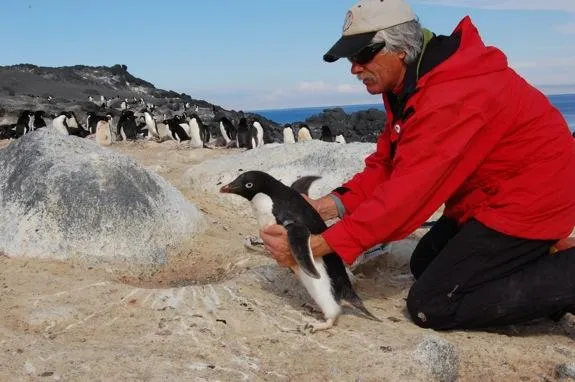Can Birds Survive Climate Change?
Predicted increases in torrential rain and severe drought will force birds in Asia to relocate in search of food and viable habitat, a new study finds
/https://tf-cmsv2-smithsonianmag-media.s3.amazonaws.com/filer/20130208105156Indian-Peafowl-3.jpg)
In the coming years, the birds of Asia’s Eastern Himalaya and Lower Mekong Basin, considered biodiversity hotspots by scientists, will need to relocate within the region to find viable habitat, according to a new study published in the journal Global Change Biology. The reason? Climate change. Researchers at England’s Durham University tested 500 different climate-change scenarios for each of 370 Asian bird species and found that every possible climatic outcome–even the least extreme–would have an adverse effect on the birds.
The researchers honed in on sensitive habitat in Bhutan, Laos, Cambodia, Vietnam and parts of Nepal and India, where development and population growth are occurring at a rapid clip and the effects of climate shifts are expected to be significant, with both wet and dry seasons intensifying. Portions of the region will suffer drastically, the study authors wrote, and certain climates will have “no present-day analogues” by 2100.
This will send birds in search of food. “Food availability more seasonal, meaning that in some periods there is an over-abundance of food, in others the birds starve,” lead author Robert Bagchi, formerly of Durham University and now a senior scientist at ETH Zürich, told Surprising Science. Species in the Lower Mekong Basin, which includes Laos, Cambodia and Vietnam, will be most vulnerable to these shifts.
In the most extreme cases, the research showed, birds will need to be physically relocated–an outcome scientists are hoping to avoid. Instead, they’re recommending proactive conservation. “Maintaining forest patches and corridors through agricultural landscapes is likely to be a far more effective and affordable long term solution than translocation,” Bagchi said. Linking bird habitat will be key so that species can move between sites that are currently viable and those that will suit them in the future.
The ramifications of bird relocation on plants and other animals has yet to be examined, but the shifts likely won’t bode well. Plant species that rely on birds to disperse seeds may not be able to survive, according to Bagchi. “Understanding how species interactions are going to change is very much at the cutting edge of what ecologists are trying to understand at the moment,” he said.
The study joins a growing body of research into how changes in climate affect food and water supplies, ranges, breeding habits and life cycles for birds and a variety of wildlife. Among those studied and deemed at risk are California’s threatened and endangered bird species. Research published last year showed that sea-level rise and changes in precipitation will most seriously imperil wetlands birds.
Investigators with the National Science Foundation are currently studying the prospects of Antarctica’s Adélie penguins for surviving climate change; the birds rely on floating sea ice, and if warmer temperatures melt that ice, the penguins will vanish. The top swimmers and foragers among their ranks have the best chances of survival, according to researchers, whose work is detailed in this video.

Among mammals, the adverse impacts of global warming on polar bear habitat has been well documented. A 2011 study showed the bears must swim longer distances in search of stable sea ice and that cubs are 27 percent more likely to die as a result of the extended plunges. New research published in the journal Ecology reveals that elephants are also vulnerable: Higher temperatures and lower precipitation have created an acute threat to Myanmar’s endangered Asian elephants, particularly babies.
Land-dwelling North American animals have also been affected. The snowmelt required by wolverines for reproduction is so greatly diminished that federal wildlife officials nominated the animal for Endangered Species Act listing earlier this month. And climate-change-induced, late-spring snowfalls have caused the Columbian ground squirrel to extend its Rocky Mountains hibernation by ten days over the past 20 years, according to Canadian researchers. By emerging later, the animals lose valuable time to stock up on the food they need to survive the next winter.
Conversely, another hibernator, the yellow-bellied marmot, was shown in a 2010 study to actually thrive in the face of climate alterations–a phenomenon scientists attributed to earlier-spring plant growth. But they predicted the benefits would be short-lived due to an increasingly serious climatic pitfall: drought.
Meanwhile, as temperatures continue to rise, other wildlife and insects are expected to flourish outright, including certain invasive species that will be able to expand their ranges and survive winters in new places, as well as non-invasive species. A recent Discovery news article highlighting climate-change winners focused on the brown argus butterfly, which has found a new host plant and a larger range; the albatross, whose food-finding ability has gotten a boost from shifting wind patterns; and the Australian gray nurse shark, whose population could boom if warmer waters reunite two separate populations. Also, melting Arctic ice could provide new feeding opportunities for orcas–but if so, two species it preys on, belugas and narwhals, would move into the climate-change losers column.